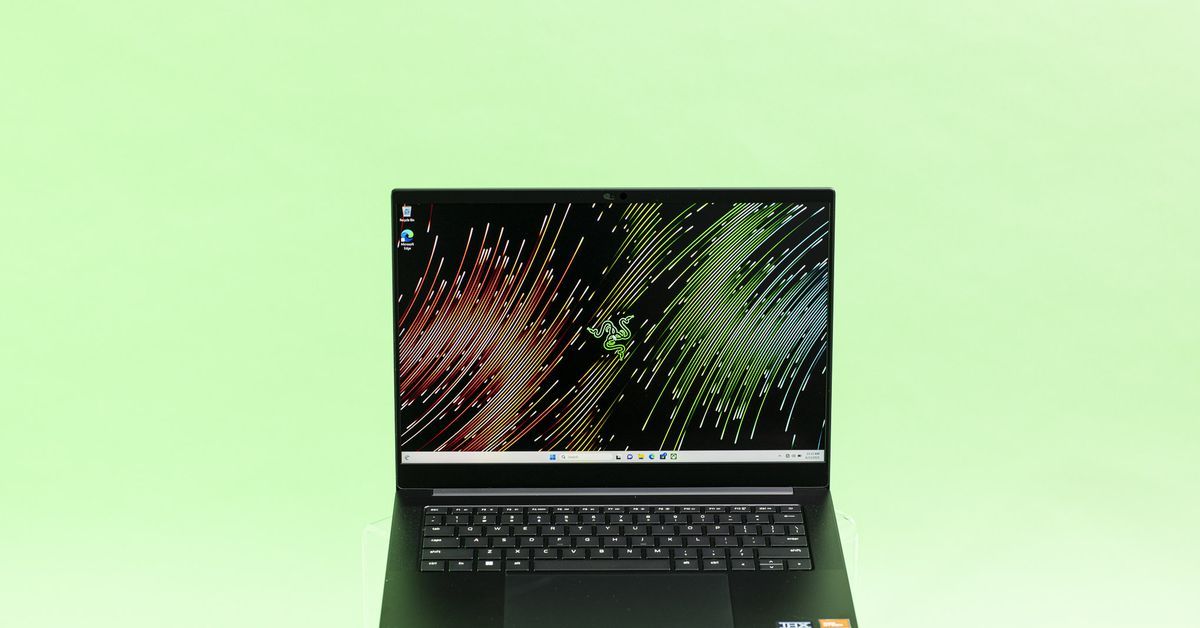Razer Blade 14 (2023) review: this pricing is silly
The 14-inch gaming laptop space basically has two products in it. Sure, there are others here and there. But if you come up to me saying you want a 14-inch gaming laptop, barring very extreme circumstances, I am going to be recommending you one of two.
There have been years when the decision between the Asus ROG Zephyrus G14 and the Razer Blade 14 was a tough one. But 2023, it appears, may not be one of those years.
The Blade 14 is Razer’s fastest 14-inch laptop to date. It has one of AMD’s most powerful mobile CPUs inside, the Ryzen 9 7940HS — and it’s a monster of a chip, with eight cores, a 5.2GHz boost frequency, and 54W TDP. It is, in a vacuum, a great device.
But the pricing relative to its closest competitor makes very little sense to me. The Blade 14 model I received (which has a 16:10 / QHD+ / 240Hz screen, 1TB of storage, 16GB of memory, and an Nvidia GeForce RTX 4070 inside) is $2,699. An Asus ROG Zephyrus G14 with the exact same resolution, storage, memory, processor, and GPU is currently available for $1,849.99 — with the only difference being a slightly lower-refresh-rate screen. (Heck, you can even get a 14-inch MacBook Pro with this storage and memory for quite a bit cheaper.)
To justify that $850 price increase, the Blade 14 would need to be an exceptional, brilliant, out-of-this-world performer. It isn’t. It’s just good.
7 Verge Score Razer Blade 14 (2023) $ 2399.99 The Good Powerful chips in a thin chassis
16:10, QHD+, 240Hz screen
RGB keyboard
Physical webcam shutter The Bad Absurd pricing
Speakers could be better
Fingerprint magnet $2400 at Razer How we rate and review products
These can be up to 16.8 million colors.
I won’t be going into all that much detail about the Blade 14’s chassis here because if you’ve seen one Razer Blade before, you’ve basically seen them all. Uniformity is a hallmark of the Blade line: they’re sleek, they’re thin, they have subtle RGB keyboards, and there’s a green snake logo on the lid.
Since last year, the Blade 14 has gained a 16:10 screen, a slightly bigger touchpad, and some new battery optimizer thing (plus you can upgrade both RAM slots now, which is handy), but gaming on it does not feel broadly different from gaming on its predecessors, or on the various other Blades that I have puttered around with during my career. It remains a premium black build with a colorful keyboard. It still retains quite a few fingerprints. The big updates are on the inside.
Physical webcam shutter is nice.
The Blade averaged 220fps on CS:GO at native resolution and 67fps on Red Dead Redemption 2, also at native resolution. I saw an average of 99fps on Shadow of the Tomb Raider with ray tracing off and 64fps with ray tracing on. Don’t get me wrong: these are fine scores that are in line with what we’d expect to see from an RTX 4070.
But I’d like to, just as a thought experiment, compare them to the scores I saw from the Razer Blade 18 earlier this year. That device had an RTX 4080 in it, and the scores on these titles at QHD resolution are not even close. They are not batting in the same league. They are hilariously far apart.
Now, obviously, we would not expect a 14-inch laptop of this size to be performing anywhere near an 18-inch-plus gaming rig under basically any circumstances. I do, however, feel that the sheer size of the gap between these two systems (the Blade 18 did closer to 50 percent better on Tomb Raider) can perhaps help to illustrate the additional power that an RTX 4080 can provide. As of this writing, you can purchase a Zephyrus G14 with an RTX 4080 for $2,499.99, which is $200 less than this test model of the Blade 14. That... well, it doesn’t make a whole lot of sense.
In fact, there doesn’t even appear to be a Blade 14 with a 4080 available; the models listed on Razer’s site stop at a 4070. The G14, on the other hand, can pair the same AMD processor with a 4090.
There doesn’t even appear to be a Blade 14 with a 4080 available
One other observation from my testing period: I used the “Max Fan Speed Mode” in Razer’s Synapse settings in order to eke out the most performance I could, and I assume that other buyers may want to do the same. Just be prepared: the fans lose their minds when you turn this on. They gun, and they gun, and they do not stop. The Blade’s speakers, while not terrible, did not have volume enough that I could hear game audio at any comfortable degree over the fans’ constant commotion — music came through, but dialogue was often muddled. I do not illustrate this as a criticism; it is not a crime for something called “Max Fan Speed Mode” to cause fans to move very fast. I just want to make sure you are warned.
(These very excited fans did, fortunately, do their job. The 7940HS stayed within the mid-70s to mid-80s (Celsius) for most of my game testing, with only very occasional jumps to the high 90s. That’s impressive, considering that we’re dealing with a 14-inch chassis and also that Razer Blades are generally known to be giant fireballs.)
I appreciate the port selection, which has a good lineup on both sides. That’s the charging port on the far left.
Battery life did not blow me away. I got six hours and 13 minutes of general use and an hour and nine minutes of gaming battery (about 56 minutes playable, tested with Red Dead Redemption 2). That’s a decent lifespan among today’s gaming laptops and certainly beats other Blades, but it’s not the earth-shattering all-day result that we’ve seen from AMD systems of yore. And, at risk of sounding like a broken record, I must note that the more affordable G14 has a bigger battery.
Razer Blade 14 specs (as reviewed) 16-inch QHD+ (2560 x 1600), 240Hz, 3ms response time, 14-inch IPS display
AMD Ryzen 9 7940HS (8 cores, 16 threads, 16MB L3 cache, up to 5.2 GHz max boost) with Radeon 780M graphics
Nvidia GeForce RTX 4070 (140W TGP)
16GB DDR5-5600MHz (slotted), upgradable to 64GB
1TB SSD storage (M.2 NVMe PCIe 4.0 x4), upgradable to 4TB
Windows Hello built-in IR FHD webcam (1080p) with Privacy Shutter
Qualcomm WCN6856 Wi-Fi 6E, IEEE 802.11a/b/g/n/a/ac/ax, Bluetooth 5.2
68Whr lithium-ion polymer battery
Overall, the 2023 Blade 14 is a solid laptop with a really strong processor inside that could be a real mainstream success — except that its high price pushes it into a pretty niche category.
I can think of three possible advantages that the Blade 14 could have over a Zephyrus G14 that has the exact same chips inside. There’s the higher-refresh-rate screen. There’s the RGB keyboard. There’s the fact that it’s three-tenths of an inch thinner (though it is also, I will point out, close to half a pound heavier). And then there’s the general aesthetic; some people no doubt prefer the Blade’s unobtrusive black to the G14’s slightly more eclectic dot matrixes and such.
But that’s it. And even if all those things are true, I don’t see the $850, and I can’t imagine my eventual testing of the G14 changing my mind unless our test unit is a complete potato. Even in that eventuality, I think even someone willing to pay this amount of money should be seriously considering the G14’s 4080 model as an alternative, which will deliver substantially better frame rates for still less than this Blade model costs.
Again, I won’t say that nobody should buy this. But you need to really, really want a Blade.
Source: The Verge


